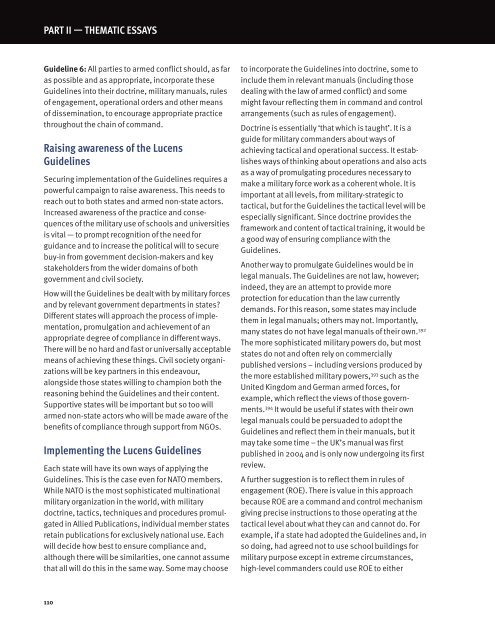You also want an ePaper? Increase the reach of your titles
YUMPU automatically turns print PDFs into web optimized ePapers that Google loves.
PART II — THeMATIC eSSAYS<br />
Guideline 6: All parties to armed conflict should, as far<br />
as possible and as appropriate, incorporate these<br />
Guidelines into their doctrine, military manuals, rules<br />
of engagement, operational orders and other means<br />
of dissemination, to encourage appropriate practice<br />
throughout the chain of command.<br />
Raising awareness of the Lucens<br />
Guidelines<br />
Securing implementation of the Guidelines requires a<br />
powerful campaign to raise awareness. This needs to<br />
reach out to both states and armed non-state actors.<br />
Increased awareness of the practice and consequences<br />
of the military use of schools and universities<br />
is vital — to prompt recognition of the need for<br />
guidance and to increase the political will to secure<br />
buy-in from government decision-makers and key<br />
stakeholders from the wider domains of both<br />
government and civil society.<br />
How will the Guidelines be dealt with by military forces<br />
and by relevant government departments in states?<br />
Different states will approach the process of implementation,<br />
promulgation and achievement of an<br />
appropriate degree of compliance in different ways.<br />
There will be no hard and fast or universally acceptable<br />
means of achieving these things. Civil society organizations<br />
will be key partners in this endeavour,<br />
alongside those states willing to champion both the<br />
reasoning behind the Guidelines and their content.<br />
Supportive states will be important but so too will<br />
armed non-state actors who will be made aware of the<br />
benefits of compliance through support from NGOs.<br />
Implementing the Lucens Guidelines<br />
Each state will have its own ways of applying the<br />
Guidelines. This is the case even for NATO members.<br />
While NATO is the most sophisticated multinational<br />
military organization in the world, with military<br />
doctrine, tactics, techniques and procedures promulgated<br />
in Allied Publications, individual member states<br />
retain publications for exclusively national use. Each<br />
will decide how best to ensure compliance and,<br />
although there will be similarities, one cannot assume<br />
that all will do this in the same way. Some may choose<br />
to incorporate the Guidelines into doctrine, some to<br />
include them in relevant manuals (including those<br />
dealing with the law of armed conflict) and some<br />
might favour reflecting them in command and control<br />
arrangements (such as rules of engagement).<br />
Doctrine is essentially ‘that which is taught’. It is a<br />
guide for military commanders about ways of<br />
achieving tactical and operational success. It establishes<br />
ways of thinking about operations and also acts<br />
as a way of promulgating procedures necessary to<br />
make a military force work as a coherent whole. It is<br />
important at all levels, from military-strategic to<br />
tactical, but for the Guidelines the tactical level will be<br />
especially significant. Since doctrine provides the<br />
framework and content of tactical training, it would be<br />
a good way of ensuring compliance with the<br />
Guidelines.<br />
Another way to promulgate Guidelines would be in<br />
legal manuals. The Guidelines are not law, however;<br />
indeed, they are an attempt to provide more<br />
protection for education than the law currently<br />
demands. For this reason, some states may include<br />
them in legal manuals; others may not. Importantly,<br />
many states do not have legal manuals of their own. 392<br />
The more sophisticated military powers do, but most<br />
states do not and often rely on commercially<br />
published versions – including versions produced by<br />
the more established military powers, 393 such as the<br />
United Kingdom and German armed forces, for<br />
example, which reflect the views of those governments.<br />
394 It would be useful if states with their own<br />
legal manuals could be persuaded to adopt the<br />
Guidelines and reflect them in their manuals, but it<br />
may take some time – the UK’s manual was first<br />
published in 2004 and is only now undergoing its first<br />
review.<br />
A further suggestion is to reflect them in rules of<br />
engagement (ROE). There is value in this approach<br />
because ROE are a command and control mechanism<br />
giving precise instructions to those operating at the<br />
tactical level about what they can and cannot do. For<br />
example, if a state had adopted the Guidelines and, in<br />
so doing, had agreed not to use school buildings for<br />
military purpose except in extreme circumstances,<br />
high-level commanders could use ROE to either<br />
110


